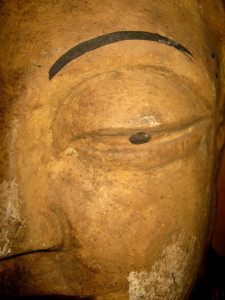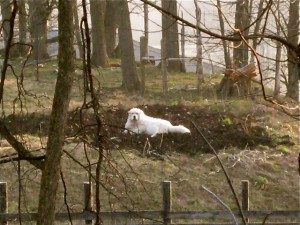
– Photo by Jan Ketchel
I attended a silent meditation retreat some weeks ago. I am not ordinarily a retreat kind of person. I am not a group person. I am a loner, but occasionally I find that going outside of my container offers the opportunity for new vitality and renewed commitment to my path. For me, it was to be a day of stalking, for I was leaving my known world and entering into an unknown world. I would have to be appropriate. Proper attire was required, white clothing, modestly covering arms and legs. Yoga and meditation, as well as teaching, would be part of the day long retreat. I stalked from the moment I got up in the morning and dressed. I followed the rules, arrived on time, ready to begin.
Things did not happen according to schedule. No one was ready for the arrival of the retreat attendees. We had to be patient. As we stood about, some attendees chanted softly to themselves, others practiced yoga, preparing themselves for the day ahead. I walked the grounds of the retreat center, calmly and slowly, already in silent meditation. Talking seemed unnecessary and inappropriate. I exchanged a few nods.
Three ravens flew into some trees ahead of me. I stood and watched as they landed, as they ruffled their feathers, and as small white down loosened and slowly fell to the ground. I heard more rustling and noticed a couple more ravens sitting on nearby branches. I saw more white down flutter to the ground. Suddenly, I became aware that I was surrounded by ravens. Out of the darkness of the leaves the shapes of perhaps fifty or sixty ravens appeared, materializing a few at a time, as if by magic. Raven energy, I thought, the scavengers who pick away at the dead, transforming empty carcasses into something new. Not a bad omen, I thought. I wondered what the day would bring. New life, new energy perhaps?
I walked slowly among the birds as if walking beside the ocean, the rustling of their feathers, like the sound of gentle waves washing upon the shore, accompanying me. I walked in a large circle, respectfully passing by the ravens several times as I waited for the retreat to begin. Eventually, the doors opened. Leaving our shoes at the door, we entered the coolness of the building.
Eventually a yoga instructor emerged. Pranayama, breathing, was followed by a series of chakra and meridian opening poses. I was quite at home, but it was an experience to do yoga in a room filled with perhaps 60 or more people. I began to experience a gentle energetic vibration as the session progressed, as creative energy coursed through all of us. The yoga ended with shavasana, as we all stretched out on the floor and sank into calm relaxation.
Chanting followed, in Sanskrit, which is foreign to me. I can chant some simple mantras, and my personal yoga practice involves personal mantras, mostly in English. Suddenly, however, it seemed as if everyone else in the room could speak the language. All of the other attendees were chanting away with gusto, the beautiful syllables flowing off their tongues as the room filled with vibrant, lilting energy. I sort of hummed along, but I realized I was an outsider, that most of the people at the retreat were seasoned and dedicated practitioners of a specific yogic path, used to satsang, used to group energy, used to practicing together. But even though I was not a member of this greater community, I felt welcomed into it, and there I was, as I mentioned, stalking.
In stalking, one allows the circumstances to dictate the process, even as one makes the initial decision to stalk. In alignment with my wish to have a personal experience, to see what happened, I had embarked on the day, and so I was open and receptive, perhaps a little too much, for as the chanting grew louder, I began to vibrate even more than I had vibrated during the yoga session.
I realized that I was taking in the energy and that perhaps it was too much. I stopped chanting. As good as the energy in the room felt, I could not accept any more of it. It was group energy, and a lot of people thrive on it, but I do not. I am not like the ravens who live in flocks; I am a solitary bird. And so I was relieved when it was time to take a break before the first meditation session began with the guru.
Soon the guru appeared, a tiny woman, revered by the many practitioners who had come to be in her presence. I knew little about her. I have never felt the need of a guru, but I sensed the deep affection that filled the room as she entered and took her place. She was serious, her energy almost heavy, as if she had to bear the weight of adoration and she was uncomfortable with it. This assessment of her proved true, for later it was revealed that she preferred not to be revered in any way.

– Photo by Jan Ketchel
Without further ado, she guided us into pranayama and then meditation. Meditation must be preceded by pranayama, and end with pranayama, she said. Do Yoga, pranayama, meditation, pranayama. Duration, one hour, she stated, as we began. If negative thoughts arise, she said, say your mantra, whatever it is, five times, then silence. Negative thoughts, mantra, silence. One hour.
Thoughts immediately arose. Is that a negative thought? I’d ask myself. Or is it just a thought. Does it matter? A thought is a thought. Mantra, what mantra should I say? Okay, I’ll say that: Mantra, five times, silence. This became the mantra I said as the meditation session began. “Mantra, five times, silence.”
Fifteen minutes passed. My legs hurt. I heard other people moving about, shifting on their cushions, some quite loudly. I carefully moved one leg, then the other, stretched them out for a time. I pulled my knees in and hugged them for a time. I got back into sukasana, sweet pose, with legs crossed. Another fifteen minutes passed. I knew how many minutes had passed by my body, from my years of sitting in meditation. I knew that soon, in the next few minutes, I would level out and not feel a thing, that by the time 45 minutes had passed I’d be floating, effortlessly present in my body. It happened as expected. It was then that I received this mantra: Look into your darkness until you see the eye of God.
I followed the instructions. I looked into the darkness behind my eyes, a place I look into often, a place where I have had some of my most enlightening and magical experiences, in my own darkness. I looked for the eye of God. Almost immediately an eye appeared. I saw the eye of the meditating Buddha head that we have at home. I saw the eye of an elephant. I saw the eye of a snake. I saw the beady eye of a mouse. I saw the eye of a lion. I saw many eyes floating in and out of the darkness, coming and going. Eventually I saw a big bright eye, staring right at me. Is that the eye of God? I wondered, and then I saw that it was my own eye staring at me. As if I was looking into a mirror, my own eye held my gaze, and then it was gone. I had seen the eye of God, and it was my own.
I had peeked at the guru several times during the meditation session. Every time I looked she was sitting perfectly still, a slight smile on her smooth face. Her head was tilted slightly, as if she were listening to someone speaking in her ear.
With the meditation session over, the guru softened, the stern look and the heaviness that she had entered the room with released a little as she smiled and joked. After a while, I began to feel like a student sitting at the foot of the teacher and I did understand why her flock tended to revere her as a guru. I became a part of their community once again, just as I had during the yoga session, the group energy like a blanket hovering just above our heads.
The guru spoke wisely, her concerns for the world in alignment with my own, her healing approach similar to my own as well. In simplicity and alignment with nature, with what we are granted naturally we can save ourselves, we can save the people of the world. Her greatest concern seemed to be with what we put into our bodies, with the contaminated food that is found in every American supermarket. “That’s not food,” she said, “that comes from processing plants. Food is real.” With the right foods in our bodies, we can access greater spiritual practice and we can change ourselves and our world, she said. I felt, for the most part that she was preaching to the choir, so to speak, but perhaps not. Perhaps too many people, even those in deep spiritual practice, dressing the part and knowing all the words, struggle as much as those who have no practice and no words to resort to.
We broke for silent lunch. I was thankful for the gift of silence, to sit and write my thoughts, to eat slowly of the ayurvedically seasoned and balanced meal, food for sitting in meditation—no rajas, no tamas, just sattva—nothing that will interfere with going into silence.
The afternoon started with more teaching by the guru. And then a man got up and stood before a microphone. I didn’t quite hear what he said, as he spoke too quickly, but everyone else seemed to know exactly what was happening as more chanting began. Again I could not keep up, although I hummed along for a time, but I had no sense of what it meant. The words projected on a screen in front of us seemed endless. Surely that’s the last of it, I’d think, and then another screen filled with phrases would pop up. Loud and fervent chanting filled the room, with the shrillness of bells ringing, a radiant energy building. Suddenly, I began to feel ill. Would it never end? Everyone around me seemed transfixed, mesmerized. Then it dawned on me that they were chanting the 108 divine names of the guru. What number were we on, surely we’d already done fifty.
Finally the chanting ended. It was evening, close to the time when the retreat should end. Time for a short break, but there was still the afternoon meditation to come. Shaking, I got up quickly. My stalking time was over. I had to go back to being me. I gathered my things and exited the building. I could not stay another second. I had to get away from the energy. How could I feel like that after being in that beautiful presence? I wondered, for I did feel the beauty and dedication of the guru, dedicated to her life’s task, to bring to the world what she had learned in the manner of her ancient tradition. It was her path. It was not my path. I am on a different journey. We all walk our paths, some parallel to others, some joining for a time, but in the end they are individual paths.

– Photo by Jan Ketchel
My stalking self shed her persona as I slipped into my sandals at the front door and walked to my car. Shaking off the too good, the too much energy of other, I glanced over at my pals the ravens. They were still there, fluttering their wings, waiting patiently, but for what? Then I saw the dumpsters. They were waiting for food, to pick over the leftovers from the restaurant, to feast upon the energy. They had been there the entire time.
When I got home and told Chuck about the ravens, his first reaction was to remind me of the shaman’s world where they would be seen as predatory energy, also known as entities. We had produced, as a group, a lot of energy that day and the vultures where there to feed off it. As soon as he said this, it all made sense, it had been about energetic exchange, and I understood why the guru had entered with such a heaviness, as she was carrying excessive energy to feed her hungry devotees. She lightened considerably as the day progressed. But it was too much for me. I could not eat another bite of her energy.
When I left, I was more certain of my solitary journey, of my own vital and vibrant energy being enough, of my own spiritual practice, and my own road to freedom. I drove away, thankful for the experience, for it had indeed shifted me and introduced a new vital energy, just as I had hoped. Yet it also sent me right back into myself, back into my darkness, which was exactly where I needed to be, looking for the eye of God inside.
Now, whenever I sit in meditation, I have a new mantra to focus on, to swish away the thoughts, negative or otherwise: Look into your darkness until you see the eye of God. From the energy of the guru, I pass it on to you. Mantra, five times, silence.
Look into your darkness until you see the eye of God.
Namaste,
Jan








